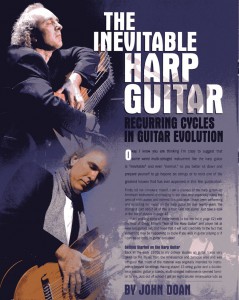 “The Inevitable Harp Guitar- Recurring Cycles in Guitar Evolution” was published in Fingerstyle Guitar Magazine No.66, and is used here with permission. For more information on harp guitar history go to harpguitars.net.
“The Inevitable Harp Guitar- Recurring Cycles in Guitar Evolution” was published in Fingerstyle Guitar Magazine No.66, and is used here with permission. For more information on harp guitar history go to harpguitars.net.
Back in the early 1970’s in my college studies on guitar I was very taken by the music from the renaissance and baroque eras and was intrigued that much of the material was originally intended for instruments beyond six strings. Having played twelve-string guitar and a double neck electric guitar in bands multi-stringed instruments seemed familiar to me. Just out of school I got an eight-course renaissance lute as well as a fourteen-course theorbo to play original lute music and included them in my guitar concerts.
Over time I began to recognize all sorts of multi-stringed instruments in some music shops, museums, and in books on instruments and was curious that hardly anyone played them or even seemed to know much about them. There were various lute-guitars (a.k.a. “lutars”) from late 19th/early 20th century Germany (those who think poorly of them call them “gututes”), Basse-guitares or Schrammel guitars from Europe (especially from Sweden, France, Germany, Italy and Eastern Europe), and harp guitars from early 20th century America.
These guitars all had an extended bass range with up to twelve additional strings. I even found a harp guitar made by Chris Knutsen in Port Townsend, Washington from the late 1890’s with seven additional super-trebles attached to the right of the ordinary six strings of the guitar. In time I acquired a Gibson harp guitar (literally hundreds were made in Gibson’s first twenty years), a Dyer harp guitar (made by the Larson brothers and still popular today especially since adopted by such great players like Michael Hedges and Stephen Bennett, among others), and various lesser known makes. I finally commissioned a twenty-string harp guitar (perhaps the first modern constructed harp guitar design in our times) from John Sullivan and Jeffrey Elliott of Portland, Oregon in 1985 and haven’t looked back since. *(note: William Eaton was building amazing multi-stringed creations of his own even before this).
The Evolution of the Guitar – A Historical Perspective
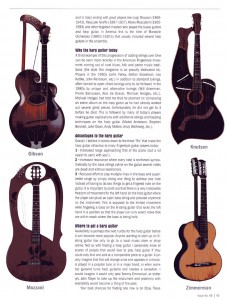 At concerts I am often asked if I invented the harp guitar. I tell them that it once was a popular American instrument a century ago played in Mandolin Orchestras, Vaudeville shows, and in parlors across the country and I get the sense that many still don’t believe me. They say, “then why haven’t I hear of it before?” I tell them that it was before their time and perhaps since it has not been featured in a movie it has not become a part of a popular notion of the past. One can only imagine the curious looks a mandolin would have received if Bill Monroe had not resurrected it from the bygone Mandolin Orchestra days to the up-tempo of bluegrass music!
At concerts I am often asked if I invented the harp guitar. I tell them that it once was a popular American instrument a century ago played in Mandolin Orchestras, Vaudeville shows, and in parlors across the country and I get the sense that many still don’t believe me. They say, “then why haven’t I hear of it before?” I tell them that it was before their time and perhaps since it has not been featured in a movie it has not become a part of a popular notion of the past. One can only imagine the curious looks a mandolin would have received if Bill Monroe had not resurrected it from the bygone Mandolin Orchestra days to the up-tempo of bluegrass music!
If we go way back in time we might find that the guitar’s humble beginnings may have started with its ancient ancestor – the harp. Some people may have found it too time consuming to make all the strings needed or too costly and tedious to string and maintain, and the larger harps may have lacked portability. Perhaps people who just wanted to sing and have some accompaniment found that a fingered chordophone (technical term for a stringed musical instrument) was all that was needed. It was ingenious when someone created a guitar-like instrument that was very portable and had fewer strings but yet approached a similar range of notes by shortening string lengths with the fingers of one hand while plucking the strings with fingers of the other.
That was all fine for an instrument that provided simple chordal accompaniment to singing but as the playing evolved melody and bass lines were added to the chords. Eventually the lowest string on the guitar is tuned downward to increase range and ease of playing and then often the instrument itself becomes tuned to a chord. Open strings could then be played more easily with fingered strings in higher positions but at the expense of a static musical language that becomes repetitive without harmonic variety from piece to piece. Players then tended to explore unique tunings for each song and eventually found themselves adding strings and evolving new ways to activate tones from the strings with either hand. Elements of this pattern have more or less repeated itself in the Renaissance, Baroque, Classical, Romantic, and contemporary eras.
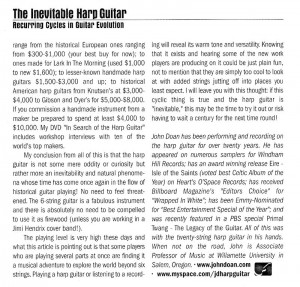 What is truly exciting about reaching the climax of an era with multi-stringed instruments is that some of the most exciting music for the instrument is conceived at that time. The lute evolved from an early renaissance version that had at least four to five courses of strings later to find lutenists like John Dowland (1563-1626) capping the late renaissance period with a ten course lute. (Do you see the increase in strings here?) The lute continued to evolve into the baroque era finally expanding to find lutenists like Sylvius Leopold Weiss (1686-1750) ending the Baroque era with an eleven to thirteen course theorbo. At this point the instrument passed out of favor along with the music and times that it once expressed.
What is truly exciting about reaching the climax of an era with multi-stringed instruments is that some of the most exciting music for the instrument is conceived at that time. The lute evolved from an early renaissance version that had at least four to five courses of strings later to find lutenists like John Dowland (1563-1626) capping the late renaissance period with a ten course lute. (Do you see the increase in strings here?) The lute continued to evolve into the baroque era finally expanding to find lutenists like Sylvius Leopold Weiss (1686-1750) ending the Baroque era with an eleven to thirteen course theorbo. At this point the instrument passed out of favor along with the music and times that it once expressed.
Another trend of adding strings can be seen starting with the renaissance guitar having four strings (basically like a ukelele) evolving into a five string baroque guitar that was followed by the early classical guitar with six strings in the late 18th century (notice the increasing number of strings?). Several of its leading players like Ferdinando Carulli (1770-1841) and Fernando Sor (1778-1839) end out the era with their respective ten string decacorde and three necked 21 stringed harpolyre. The Romantic era then ushers in popularity of seven to ten string guitars with Neopolian Coste (1805-1883) among others (especially in Eastern Europe and in Italy) ending with great players like Luigi Mozzani (1869-1943), Pasquale Taraffo (1887-1937), Mario Maccaferri (1900-1993) and other forgotten masters who played the basse guitare and harp guitar. In America this is the time of Mandolin Orchestras (1890’s – 1920’s) that usually included several harp guitars in the ensemble.
Why the Harp Guitar Today
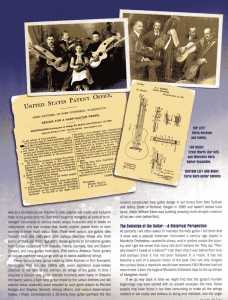 A third example of this progression of adding strings over time can be seen most recently in the American Fingerstyle movement coming out of rural blues, folk and parlor music traditions (the style this magazine is so proudly dedicated to). Players in the 1960’s (John Fahey, Stephen Grossman, Leo Kotte, John Renbourn, etc.) in addition to standard tunings often turned to open chord tunings only to be followed in the 1980’s by unique and alternative tunings (Will Ackerman, Pierre Bensusan, Alex DeGrassi, Michael Hedges, etc.). Michael Hedges had told me that he planed on composing an entire album on the harp guitar as he had already worked out several great pieces. Unfortunately he did not get to it before he died. This is followed by many of today’s players making guitar explorations with additional strings and tapping techniques on the harp guitar (Muriel Anderson, Stephen Bennett, John Doan, Andy McKee, Andy Walhberg, etc.).
A third example of this progression of adding strings over time can be seen most recently in the American Fingerstyle movement coming out of rural blues, folk and parlor music traditions (the style this magazine is so proudly dedicated to). Players in the 1960’s (John Fahey, Stephen Grossman, Leo Kotte, John Renbourn, etc.) in addition to standard tunings often turned to open chord tunings only to be followed in the 1980’s by unique and alternative tunings (Will Ackerman, Pierre Bensusan, Alex DeGrassi, Michael Hedges, etc.). Michael Hedges had told me that he planed on composing an entire album on the harp guitar as he had already worked out several great pieces. Unfortunately he did not get to it before he died. This is followed by many of today’s players making guitar explorations with additional strings and tapping techniques on the harp guitar (Muriel Anderson, Stephen Bennett, John Doan, Andy McKee, Andy Walhberg, etc.).
Advantages to the harp guitar
Overall, I believe it comes down to the three “R’s” that make the harp guitar attractive to many fingerstyle guitar players today:
- Increased RANGE approaching that of the piano (but a lot easier to carry with you!).
- Increased RESONANCE where every note is reinforced sympathetically by the bass strings (while on the guitar several notes are dead and without resonance).
- REDUCED EFFORT to play multiple lines in the bass and super-treble range by simply doing one thing to achieve one note instead of having to do two things to get a fingered note on the guitar. It is important to point out that there is a very noticeable freedom of movement for the left hand on the harp guitar where the player can pluck an open bass string and proceed anywhere on the instrument. This is opposed to the limited movement while fingering a bass on the six-string guitar that locks the left hand in a position so that the player can only select notes that are within reach where the bass is being held.
Where to Get a Harp Guitar
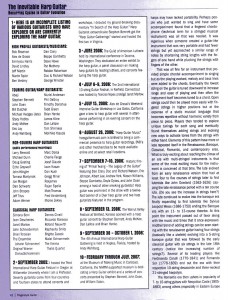 Availability is perhaps the next hurdle for the harp guitar before it can become more popular. Anyone wanting to start up on six-string guitar has only to go to a local music store or shop online. Not so with finding a harp guitar. I personally know of scores of people that would love to play harp guitar if they could only find one and at a comparable price to a guitar. I can only imagine that this will change once one appears in a movie, is played in a popular tune or in a major band, or when some top guitarist turns harp guitarist and creates a sensation. I would imagine it would only take Tommy Emmanuel, or better yet, John Mayer to take up the instrument and problems with availability would become a thing of the past.
Availability is perhaps the next hurdle for the harp guitar before it can become more popular. Anyone wanting to start up on six-string guitar has only to go to a local music store or shop online. Not so with finding a harp guitar. I personally know of scores of people that would love to play harp guitar if they could only find one and at a comparable price to a guitar. I can only imagine that this will change once one appears in a movie, is played in a popular tune or in a major band, or when some top guitarist turns harp guitarist and creates a sensation. I would imagine it would only take Tommy Emmanuel, or better yet, John Mayer to take up the instrument and problems with availability would become a thing of the past.
Your best chances for finding one now is on Ebay. These range from the historical European ones ranging from $300-$1000 (your best buy for now); to ones made for Lark In The Morning (used $1000 to new $1600); to lesser-known handmade harp guitars $1500-$3000 and up; to historical American harp guitars from Knutsen’s at $3000-$4000 to Gibson and Dyer’s for $5000-$8000. If you commission a handmade instrument from a maker be prepared to spend at least $4000 to $10,000. My DVD “In Search of the Harp Guitar” includes workshop interviews with ten of the world’s top makers.
Conclusion
My conclusion from all of this is that the harp guitar is not some mere oddity or curiosity but rather more an inevitability and natural phenomena whose time has come once again in the flow of historical guitar playing! No need to feel threatened. The six-string guitar is a fabulous instrument and there is absolutely no need to be compelled to use it as firewood (unless you are working in a Jimi Hendrix cover band!).
The playing level is very high these days and what this article is pointing out is that some players who are playing several parts at once are finding it a musical adventure to explore the world beyond six strings. Playing a harp guitar or listening to a recording will reveal its warm tone and versatility. Knowing that it exists and hearing some of the new work players are producing on it could be just plain fun, not to mention that they are simply too cool to look at with added strings jutting off into places you lest expect.
I will leave you with this thought: if this cyclic thing is true and the harp guitar is “inevitable” this may be the time to try it out or risk having to wait a century for the next time round!

Hi John,
That is a great treatise, as you predicted they would return to fashion.
Richard:
Thank you for writing. Yes, the Harp guitar is inevitable!